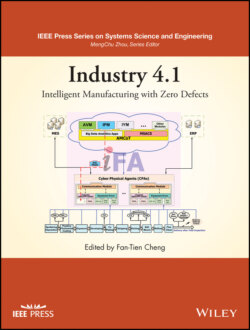Читать книгу Industry 4.1 - Группа авторов - Страница 20
1.2.1.1 Manufacturing Execution System (MES)
ОглавлениеThe MES is a shop floor control system which includes either manual or automatic labor and production reporting as well as on‐line inquiries and links to tasks that take place on the production floor. The MES provides links to work orders, receipt of goods, shipping, quality control, maintenance, scheduling, and other related tasks [17]. The mission of MES is to increase productivity and yield.
Figure 1.3 presents the MES operation procedures in semiconductor manufacturing. In Figure 1.3, a front opening unified pod (FOUP), containing 25 wafers, is processed via lithography, etching, and implantation. After finishing its procedures in the lithography process, the FOUP is prepared for the etching process by the MES. First, the MES client requires a material control system (MCS) to move the FOUP to the process equipment. When the FOUP arrives at the etching equipment, the equipment manager sends a message to notify the MES, reads the information of work in process (WIP), acquires a recipe for this FOUP from the recipe management (RM) system, and initiates fabrication. Next, the equipment manager sends the process data of each wafer under fabrication to the statistical process control (SPC) server for quality monitoring. Eventually, the equipment manager updates the WIP information when the etching process completes and asks the MCS to move the FOUP from the etching equipment to the implantation equipment.
Figure 1.3 MES operation procedures.
Source: Reprinted with permission from Ref. [14]; © 2010 IEEE.
Notably, ISMT developed a SEMATECH computer‐integrated manufacturing (CIM) framework (Figure 1.4) [1] to specify the common MES infrastructure and the software functions of MES applications, and incorporate those MES applications into a coherent system. By specifying the standard interfaces and behaviors of the common MES components, manufacturers can collect system components from multiple suppliers. Thus, manufacturers can develop systems by extending the common components and substituting old components with improved ones of the same interfaces and behaviors.
Figure 1.4 Functional architecture of the ISMT CIM framework.
Source: Reprinted with permission from Ref. [14]; © 2010 IEEE.
The SEMATECH CIM framework is an abstract model for typical semiconductor manufacturing systems. This CIM framework is developed based on open‐distributed system and object technologies. However, the fragility and security problems are not considered in this framework. For these reasons, Cheng et al. [3] adopted the concepts of holon and holarchy to propose a holonic manufacturing execution system (HMES) framework that is also suitable for industrial application (Figure 1.5). The HMES framework not only owns the characters of open‐distributed system and object technologies but also has the properties of failure recovery and security certification.
Figure 1.5 The HMES framework.
Source: Reprinted with permission from Ref. [14]; © 2010 IEEE.
A systematic approach was proposed for developing the HMES framework of the semiconductor industry (Figure 1.5) [3]. This systematic approach starts with a system analysis by collecting domain requirements and analyzing domain knowledge. The HMES holarchy is designed through the following processes: (i) constructing an abstract object model based on the domain knowledge; (ii) partitioning the application domain into functional holons; (iii) identifying the generic parts among functional holons; (iv) developing the generic holon (GH); (v) defining the holarchy messages and holarchy framework of HMES; and finally, (vi) designing the functional holons based on the GH. The HMES framework includes many functional holons, such as the material holon, WIP holon, equipment holon, scheduling holon, etc. and is open, modularized, distributed, configurable, interoperable, collaborative, and maintainable [3].
